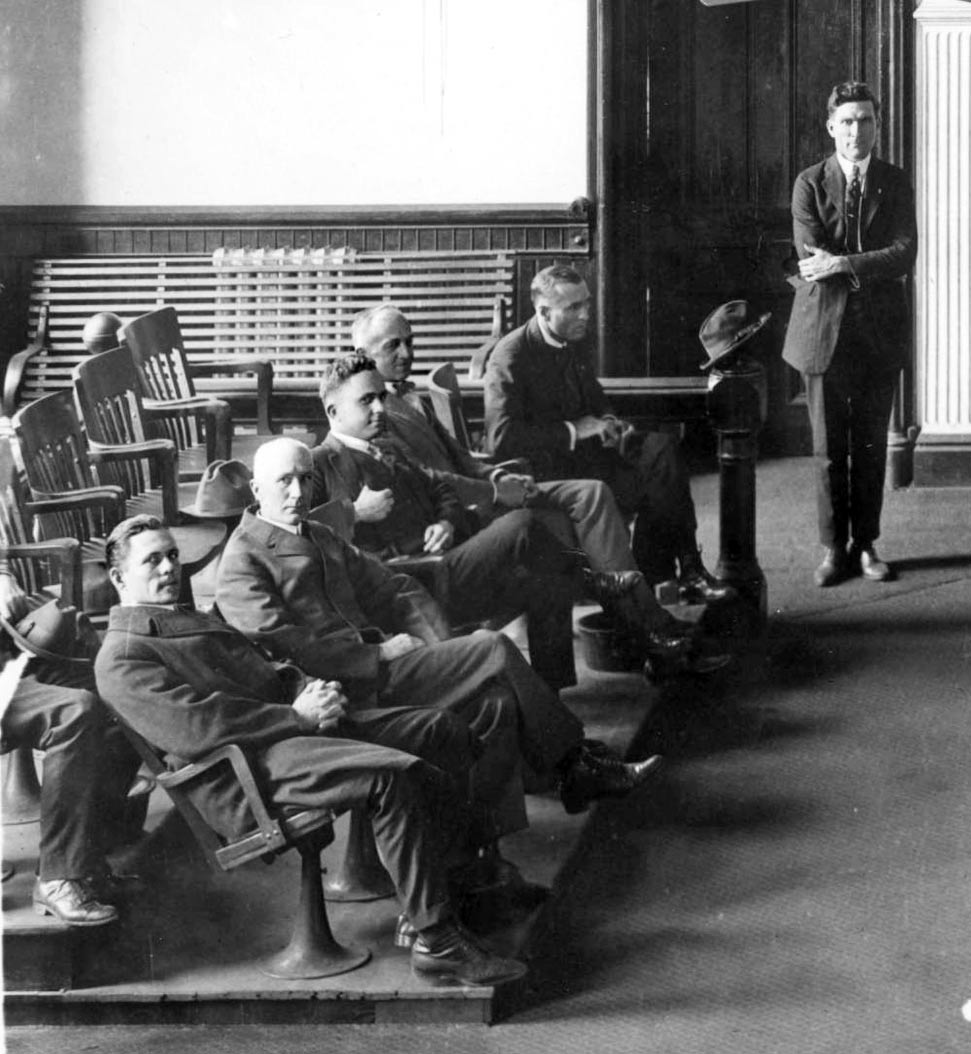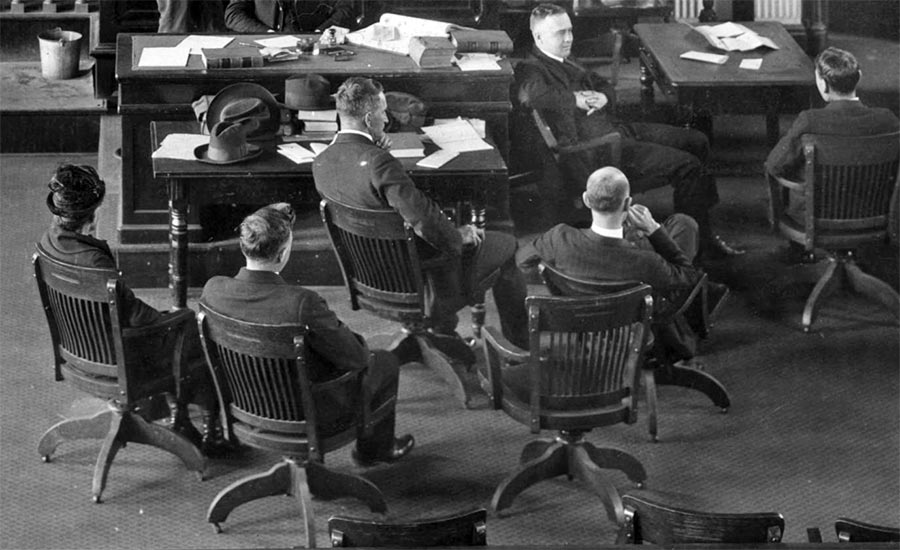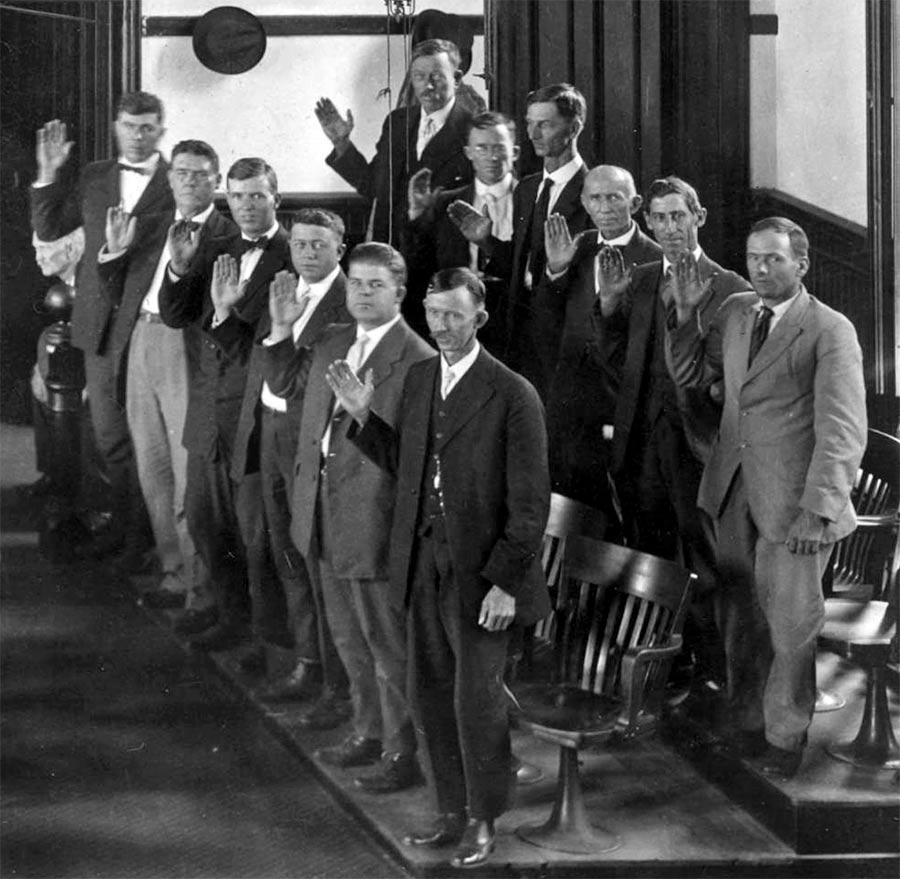|
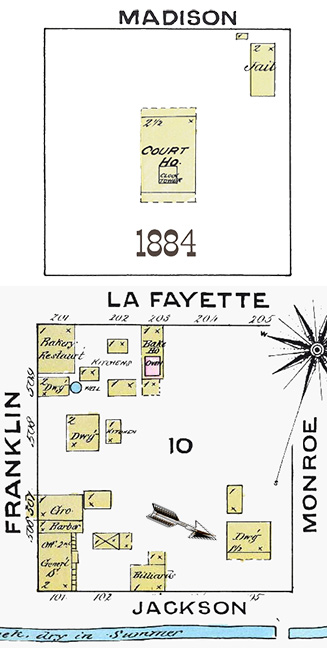
|
The Stringer house in relation to
the county courthouse in 1884.
The courthouse at left was built in 1854 and is the one in the photo below in
1889. Known unofficially as the "Breaker courthouse." it was built at a cost of $5,000 and was used until 1891. Of
course, it also had a picket fence to keep the animals out of the
courtyard. The entrance faced Lafayette St (on the right of
the photo below.)
It replaced the previous one which was built
by James McKay, Sr. in 1848. No photos exist of the McKay
courthouse, which was quite a bit smaller,
20 ft x 45 ft. and cost the taxpayers $1,358. The McKay courthouse is the
one
most refer to as the "First courthouse" although it was really the
2nd one. The actual first structure used as a courthouse, a log
building, was burned by Seminole Indians in 1836, and possibly stood
in "Courthouse Square" the northeast corner of Lafayette St. and
Franklin St.
|
|
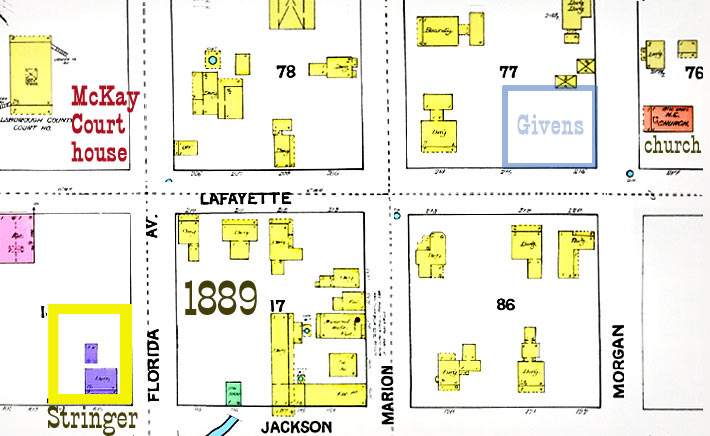 This 1889
Sanborn map from the UF digital maps collection is the
earliest that shows the area along Morgan Street. The Stringer
property is outlined in yellow. The Methodist Church can be seen in
red at the northeast corner of Lafayette and Morgan. Compare
to Jackson's plan of Tampa which showed a Baptist church planned for
there and the Methodist property across Lafayette to the south.
Evidently, the plan wasn't followed for the placement of these churches. But the Givens home isn't
shown on this map, not even on the southeast corner where the
Knights of Pythias lodge was built in 1913, the location
specified by Grismer in his 1950 "History of Tampa..."
A viable explanation would be that John T. Givens built his
house where indicated in blue on the above map, then by 1889
it had been razed. In 1913 the Knights of Pythias lodge
was built where you see vacant property at the southeast
corner, and then in 1927 the Hillsborough Lodge No. 25 was
built where the Givens house stood. D.B. Givens's story
of the Hillsb. Lodge No.25 being built where his father's
house was doesn't necessarily mean that the house was still
there when that lodge was built. Perhaps he built a new
home which we see on the southwest corner of the intersection.
|
|
THE "BREAKER
COURTHOUSE"
Burgert Brothers photo from University of South Florida Digital
Collection
Looking east on Lafayette Street from Franklin St. The first
intersection is Florida Avenue, originally named Monroe St.
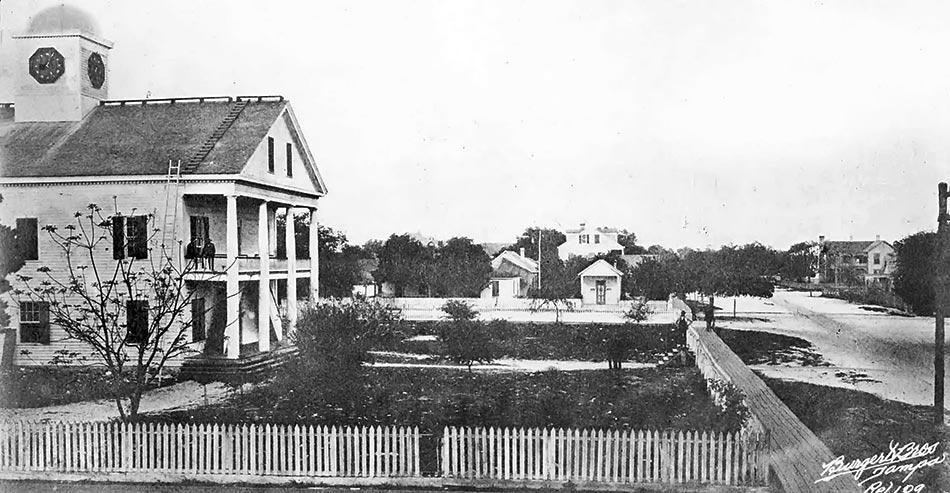 |
|
THE TAMPA
HERALD
TAMPA, FLORIDA. WEDNESDAY, JUNE 7. 1854. Our Court House.
Through the
kindness of Mr. [John H.] Breaker,
contractor and builder of this magnificent Court House, we are
enabled to furnish our readers with a full description of its order,
size, various offices, etcc. etc. The building is 76 ft. long, by 45
wide, and two stories high. The
1st
story is 12 ft. between joints; the second is 14 1/2 ft. On the 1st
floor is the City Hall, Judge of Probates, Clerks’, and Sheriff
Offices, and Grand Jurors’ room. A spacious Hall extends from the
Southern entrance of the building, between the four offices to the
City Hall.
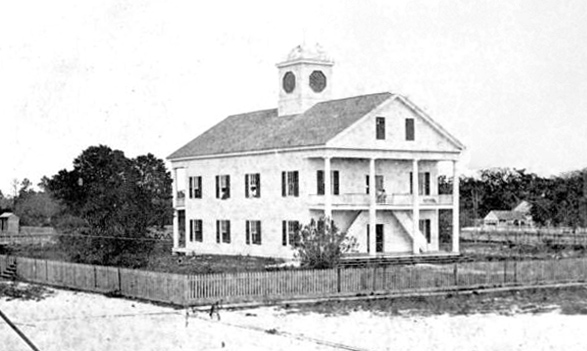 On
the 2nd floor is the Court Room, 42 by 45 ft., and two spacious Jury
rooms, with a passage extending from the south entrance, between the
jury rooms to the Court-room. A projecting Portico, an each end, the
whole width of the building supported by heavy Grecian Columns. A
double flight of stairs ascends from each end of the building,
landing - on the 2nd floor of the porticos. The roof is mounted with
a dome and tower, 18 ft in diameter, and 24 ft high, covered with
tin, or zinc. On
the 2nd floor is the Court Room, 42 by 45 ft., and two spacious Jury
rooms, with a passage extending from the south entrance, between the
jury rooms to the Court-room. A projecting Portico, an each end, the
whole width of the building supported by heavy Grecian Columns. A
double flight of stairs ascends from each end of the building,
landing - on the 2nd floor of the porticos. The roof is mounted with
a dome and tower, 18 ft in diameter, and 24 ft high, covered with
tin, or zinc.
Hillsborough County Courthouse seen from Lafayette St. and
Franklin Street, circa 1880s.
Image from Florida Memory State Archives and Library collection.
The extreme height
of the building, from the pinnacle of the tower to the ground is 68
feet; and the whole is being beautifully finished in a combination
of the Grecian, Ionic, and Corinthian orders. The plan was drawn by
the contractor, Mr. Breaker, who has engaged to erect the building,
for a sum less than $5000. The execution of this contract, we are
satisfied, will be attended with considerable loss to the builder,
unless the generosity and liberality of the County Commissioner’s
shall interpose to prevent it, for the credit of our Town and
County, we hope they will, and not in
any stingy manner.
Development of the
Stringer-Stalnaker house block and courthouse block through the years.
|
|
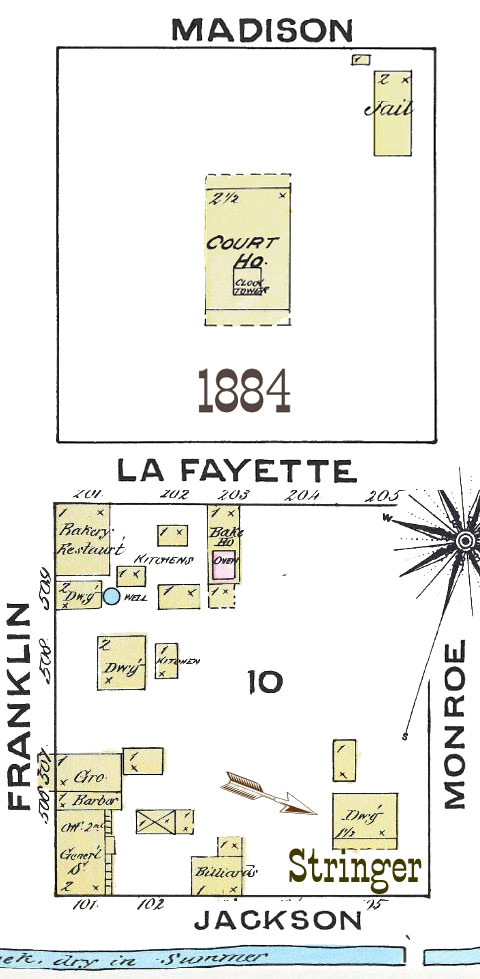 |
1884 - The "Breaker
courthouse" on the block north of the Stringer house. It consisted of the 2 1/2 story county courthouse and
the 2-story jail, both were wood frame buildings. |
|
1884 - The Stringer house
shared the block with various other wood frame businesses: grocer,
general store, barber, billiards, bakery, restaurant, a small
stable, and two smaller dwellings. Notice the creek that ran
down the middle of Jackson St., "dry in summer."
Dr. Stringer had been living in
Brooksville since the end of the Civil war, late 1860s. Mary
Stringer was living here with her children in 1860 but appears to
have moved to Brooksville with her son and daughter by 1870.
Mary died in 1874 and was buried in the Stringer plot at
Oaklawn. The house was still part of the Stringer Estate in
the 1880s.
(Continued after City Organization
section below.) |
|
|
|
|
| |
|
1887 - June 2 - The City of Tampa is established,
its first city
mayor elected July 12
|
The City of Tampa was established on Jun 2, 1887 when
under special act of the state legislature, the
Governor approved a bill that granted the city of
Tampa a new charter, abolishing the town
governments of Tampa and North Tampa. Section 5
of the charter provided for a city-wide election for mayor,
eleven councilmen and other city officials, to be held on
the 2nd Tuesday in July. The new charter also greatly
expanded the corporate limits of the city. Tampa now
took in North Tampa, Ybor City and some land on the west
side of the Hillsborough River. The
first city election under the new charter was held
July 12, 1887, and the new mayor took office on July
15, 1887, the date considered to be when Tampa was organized.
What Happened in Tampa on July 15, 1887 or Thereabouts,
by Joseph Hipp
In a hotly
contested race, George Bascom Sparkman was
elected mayor for his 4th term, defeating Henry C.
Ferris, 283 to 269.
Elected
under provision of the new city charter on July
12,1887 were George B. Sparkman-Mayor; J. Lamont
Bailey-Clerk and Treasurer; W.T. Haskins-City Marshal;
J. C. Robbins-Tax Assessor and A. M. Fleming-Tax
Collector. City Council members included:
Charles E. Harrison-President, William Benton
Henderson , President pro tempore, William A. Honaker,
Isben S. Giddens, Henry Laurens Knight, Frederick M.
Meyer, Silas L. Biglow, Candido Angel Martinez-Ybor,
Joseph A. Walker, Charles N. Brigham, and James E.
Mitchell (died 11/26/1887, and apparently his vacancy was
not filled.) Source: Council Minute Book 2, page
59.
After his
4th term as Mayor, Sparkman served on the City Council
again, from March 4, 1891, to March 4, 1892. Both of
his terms on City Council were served under the
administration of Mayor Duff Post.
|
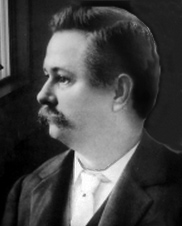 |
|
George B.
Sparkman
First Mayor elected for City of Tampa, 1887
Photo and info from Biographical Sketches of
Circuit Judges, 10th Jud. Cir. website
|
| |
|
|
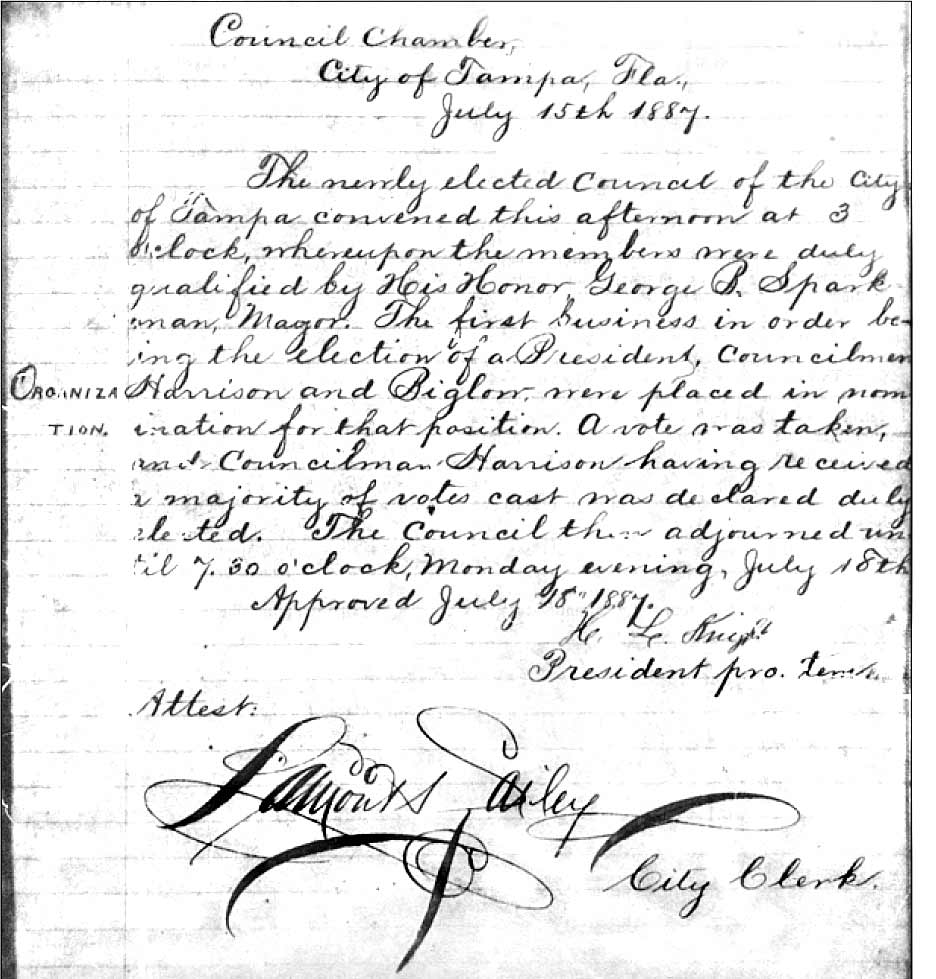 |
Council Chambers
City of Tampa, Fla.
July 15, 1887
The
newly elected council of the city of Tampa
convened this afternoon at 3 o'clock
whereupon the members were duly qualified
by His Honor George B. Sparkman, Mayor.
The first business in order being the
election of a President. Councilmen
Harrison and Biglow were placed in
nomination for that position. A vote
was taken, and Councilman Harrison having
received a majority of votes cast was
declared duly elected. The Council
then adjourned until 7:30 o'clock Monday
evening, July 18th.
Approved July 18th, 1887
H. L. Knight
President pro. tem.
Attest:
[signed] Lamont S. Bailey
City Clerk |
THE SUNLAND TRIBUNE,
Journal of the TAMPA HISTORICAL SOCIETY, Volume
VIII Number 1 November, 1982 - WHAT HAPPENED
IN TAMPA ON JULY 15, 1887 OR THEREABOUTS by
Joseph Hipp |
|
Archives, Tampa City Council Member Jan 1849-Jun 1904
City of Tampa past Mayors, George Bascom Sparkman -
19th And 22nd Mayor Of Tampa
The Mayors of Tampa 1856 - 2015,
A project of the City of Tampa
|
|
Chapter 3779 [No. 99]
AN ACT to abolish the corporations of the Towns of Tampa
and North Tampa, to provide
a municipal government for the City
of Tampa and to define the boundaries thereof.
|
Under the
provisions of the act, the city's boundaries were extended to
include North Tampa and Ybor City. The City of Tampa's
government was also to be administered by a mayor and
eleven councilmen, two elected from each of the four wards
and three elected from the city at large. Elections were
to be held on the second Tuesday of each year and other
officials such as the city marshal, city clerk, treasurer,
tax assessor and tax collector were to be elected at the
same time as the mayor and City Council. The charter also
allowed ordinances to be passed by the City Council over
the mayor's veto.
Click each image below to see larger, then click larger
image to see full size. |
|
 |
 |
 |
 |
 |
|
City of
Tampa established, former charters abolished. |
Mayor &
councilmen, first election, annual election |
Compensation, powers
|
Taxes,
loans, bonds, veto, fire limit |
Existing
indebtedness provided for, Act to take effect AT ONCE. |
1887 - July 12
The City of Tampa's first election
"...a disgrace to an
intelligent and civilized community..."
Tampa had 895 registered
voters in 1887 and the Tampa Journal reported that only 575
of these men exercised their opinion - only 64%.
Mr. Sparkman was elected as the new Mayor by 14 votes.
The Journal reported on the
election as follows:
As a
public servant, the Journal would be derelict in its duty
if it passed over some of the irregularities and
disgraceful occurrences of Tuesday’s election without
calling attention to them. It was such an election as we
hope never again to see in Tampa. For two or three days
before the election, whiskey was dispensed free by some of
the saloons. On election day the streets were lined with
drunken men; the most obscene, vulgar and profane language
could be heard, not only in the streets, but in the room
in which the election was held. Frequent rows and fights
occurred, and during the entire day and night a drunken
and riotous mob held possession of the town. Such a state
of affairs are a disgrace to an intelligent and civilized
community, and the Journal desires to place itself on
record as being opposed to any such proceedings. We
denounce the buying of votes by any man, either with money
or whiskey; we do not believe in coercion or intimidation,
and we call upon the respectable, law-abiding and
intelligent citizens of Tampa to see to it that the like
does not happen again.
Mayor
Sparkman didn't need
to concern himself with a job description. The Journal did
this for him and for his officers as well:
Many things have been promised by the newly elected Mayor
- and many reforms are hoped for. There are two or three
things to which the Journal desires to direct His Honor’s
special attention. One is the closing of the saloons on
Sundays - back and side doors as well as the front doors.
There can be no disproving the assertation that the law
has been shamefully violated in this matter. All that is
necessary to close these places effectually on Sunday is
for the policemen to do their duty.
Another important matter that demands prompt and
aggressive attention to the city’s officials is the houses
of ill-fame and their occupants. There are several of
these vile dens within the corporate limits of the city;
that they are exerting a most demoralizing and pernicious
influence on the community, there can be no question;
young men - often mere boys, are being enticed from the
path of virtue and started on the downward road to shame,
disgrace, disease and hell; their very life-blood is being
sapped by these degraded and fallen creatures. The
boldness and brazen effrontery exhibited by these women is
already notorious and shameful. Almost any hour of the day
or night they can be seen either walking or driving
through the streets, visiting the saloons and making
themselves generally conspicuous. Something must be done
to check this growing evil for the sake of the boys as
well as the girls.
The police whose duty it is to look after violations and
report the same to the proper officials simply do nothing.
You can find the whole work force lounging along the
saloon block at any time half asleep.
THE SUNLAND TRIBUNE Volume VI Number 1 November, 1980
Journal of the TAMPA HISTORICAL SOCIETY - What
Happened in Tampa on July 15, 1887, by Joseph Hipp
Historian
Karl Grismer differentiates the date
of the act of the Florida Legislature and the election of
Mayor Sparkman., in
Tampa, A History of the City and the Tampa Bay Region of
Florida, by Karl H. Grismer, edited by D. B. McKay, 1950.
The Mayors of Tampa 1856 - 2015,
A project of the City of Tampa, City of Tampa:
Incorporation Timeline |
|
|
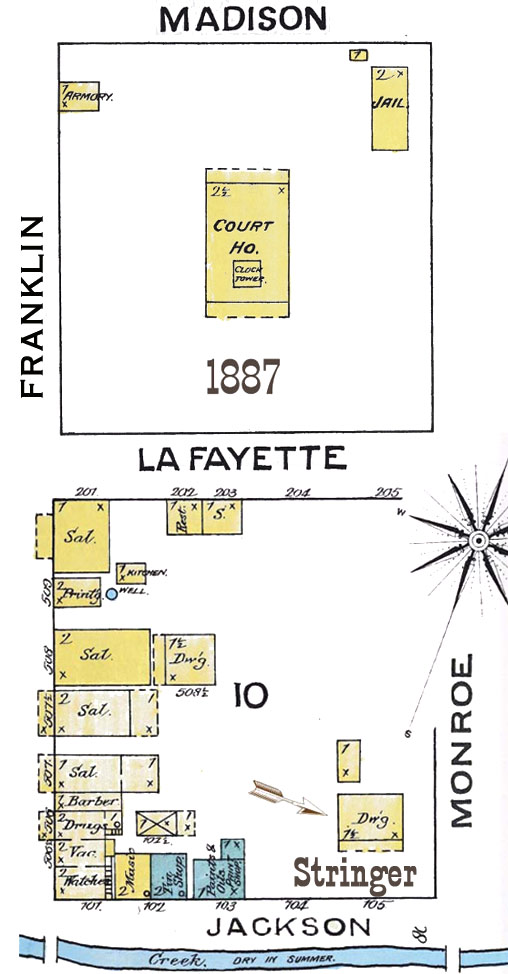 |
Development of
Courthouse Square and the Stringer block (cont.)
1887 - The Breaker courthouse at the block just north of the
Stringer house, an armory had been added by 1887. The jail is still
there.
1887 - Four saloons had opened along Franklin
Street. Two cement/stone structures are situated along Jackson
St. -- a tin shop and paints & oils shop.
The house still belonged to Sheldon
Stringer as the Stringer Estate. Dr. Stringer married in 1874 had been living
in Brooksville since the end of the Civil war, late 1860s. |
|
|
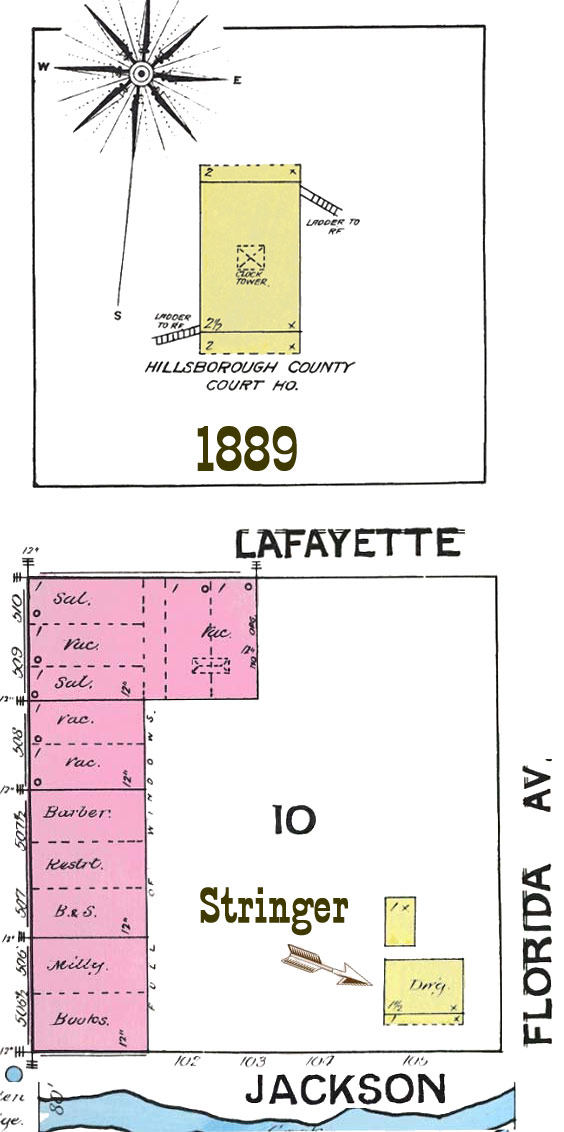 |
TAMPA PLANS ITS FIRST CITY
HALL
1889 - At the courthouse block in 1889, no major changes
were done to the building, but the armory and jail are no longer
there. Ladders can be seen propped up against the
building as seen in the previous photo. This would be the time
period of the Burgert Bros. photo which showed ladders, one of only two known existing
photos.
1889 - The great fire of Aug. 1887 wiped out the entire east
side of Franklin St. In 1889, all brick structures occupied the
block (at far left.) The Stringer house, the only wood frame
dwelling left, was miraculously spared. It still belonged to
Sheldon Stringer and was called the Stringer Estate. Dr.
Stringer had been living in Brooksville since the end of the Civil
war, late 1860s.
This is the time period of the
famous "Tibbetts Corner" photo, but the corner was on the west side
of Franklin St., not seen on this map.
|
|
On April 23, 1889 a bond election
was held for the
issuance of $100,000 of 7% bonds for internal improvements which
included the construction of a city hall, fire station and
street paving work. The result of the election was that 489
votes were cast in favor of the bonds, 7 against, and 6 marked "no
bonds." The election was ratified on April 26 by the city
council and the bonds sold to W. N. Coler & Co. of New York on May
15, 1889, and delivered through T. C. Taliaferro on June 17th.
On May 5, 1889, the city council
chose Augustus "Gus" C. Wuerpel as Fire Chief with A. J. Harris and
Manuel Rodriguez serving as first and second assistants,
respectively.
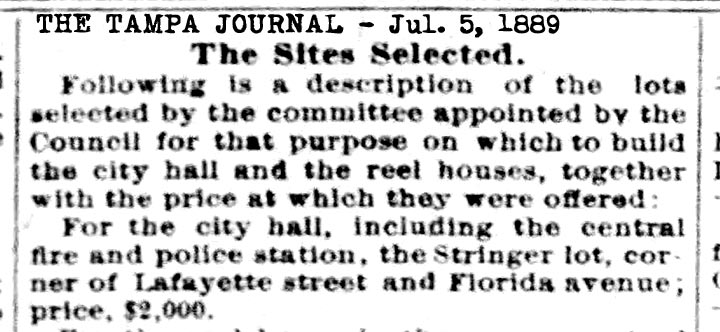 STRINGER PROPERTY SELECTED TO BUILD
NEW CITY HALL STRINGER PROPERTY SELECTED TO BUILD
NEW CITY HALL
In early July, 1889, the site was
selected to build a brick city hall. The Stringer property was
chosen at a sale price of $2,000. Apparently the Stringer
property extended the entire length of the block along Florida Ave,
from Jackson St. to Lafayette St., because the house itself was at
the corner of Florida and Jackson.
|
|
|
|

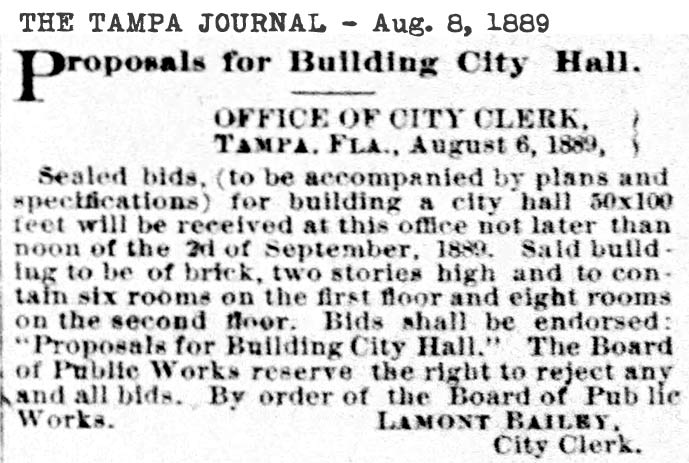
On Aug. 19, 1889, the city purchased
from Dr. Sheldon Stringer and wife Margaret, the property on which
their house was located, from Jackson St to Lafayette St. along
Florida Avenue.
The deed transferring the property indicated $2,000 was paid along
with an agreement that the property would be used for building the
new city hall.
The new city hall was to be built on the
north half of the property and no mention is made of the Stringer house
itself which occupied the south half of the lot. The house would remain to be
later used as offices/living quarters for police and/or fire personnel.
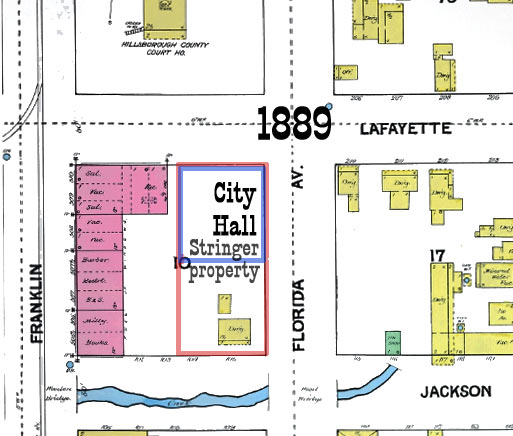
On Oct. 2, 1889, the council passed a
resolution ordering $10,000 of the $100,000 fund appropriated to the
building of City Hall. City council records during the
construction phase are virtually non-existent until nearly a year
later, Sept. 3, 1890, when a resolution was passed ordering
estimates be obtained for the lighting of the building. This
was probably due to the Board of Public Works handling the matter.
In 1915 when the Tampa Times wrote about a new city hall
replacing this one, they had to rely on memories of W. H. Beckwith,
a jeweler and watchmaker/clockmaker, to provide some details,
because they couldn't find anyone else who could even remember when
it was built.
|
|
|
CONSTRUCTION BIDDING
The first bids received by Dec. 12,
1889 were all too high.
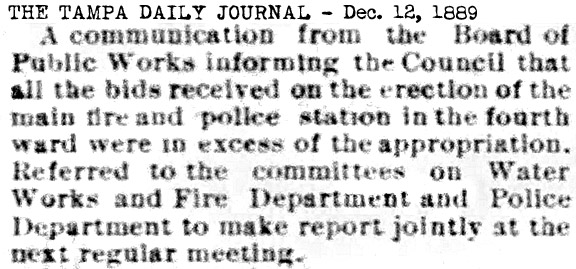
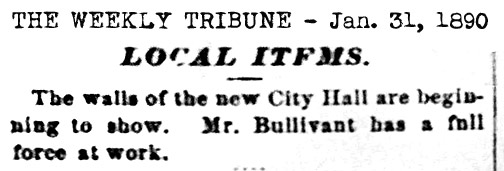 |
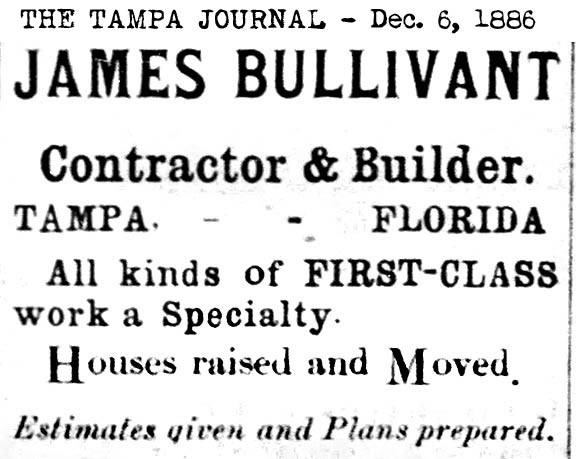
No article was found as to when the
bid was awarded, but from the Jan. 31, 1890 article at left, it is
apparent that the contract was awarded to James Bullivant, a leading
successful local contractor, who at this point had a full crew at
work.
|
|
|
|
| A reporter for
the Tampa Daily Journal published an extremely lengthy article
portraying an interview with the city clerk, Lamont Bailey, in
which the clerk provided extravagant accounts of exotic
materials and furnishings being imported from all over the world,
for the furnishing of certain offices such as the Mayor's, and
other rooms in the new city hall, creating an impression that
the interior design was going to be luxurious. But he
also exaggerated the lack of furnishings for other areas, such
as the firemen's quarters and Chief Wuerpel's office.
The article was all in jest. Below, selected excerpts
from that article. |
|
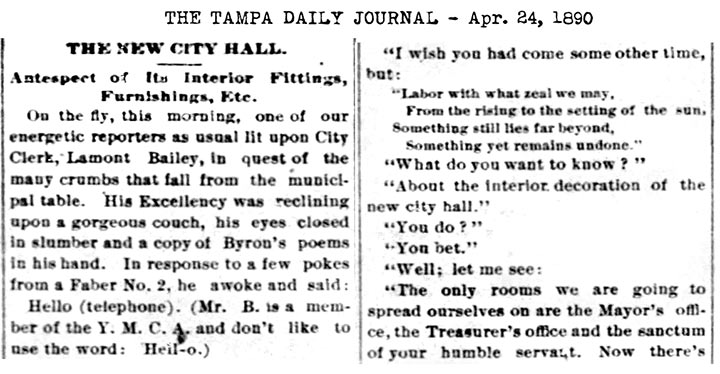 |
|
Below, the
exaggerated lack of furnishings for Fire Chief Wuerpel. |
Below, the
conclusion of the clerk's description for his own office, and
the conclusion of the article. |
|
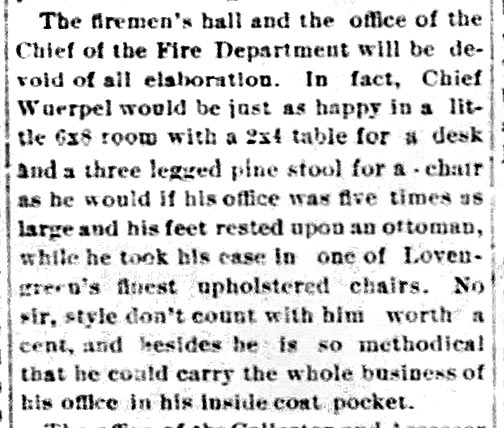
LAMONT BAILEY
Tampa City Clerk from August 13, 1886 – March 4, 1891
The first City
Clerk to serve under Tampa’s new City Charter in 1887, Lamont
Bailey came to Florida from North Carolina, where he was born
in 1861. He was the editor of the Tampa Tribune and also
contributed to other local newspapers. He was a member of the
Citizens Relief Committee which tried to address the yellow
fever outbreak in 1887. |
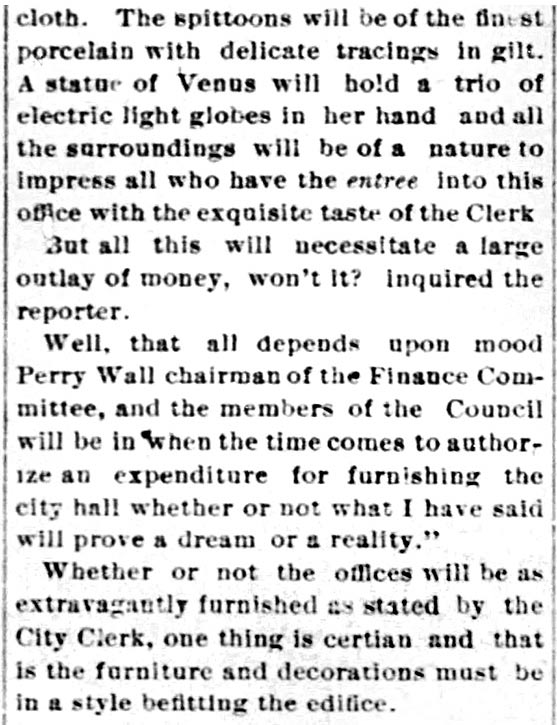 |
|
While others
assigned to this committee failed to complete their duties,
Bailey was committed and saw through his entire assignment.
After serving as Tampa’s City Clerk, Lamont Bailey went on to
serve on Tampa’s City Council from September 9, 1891 until
March 4, 1892.
From:
The City Clerks of Tampa, 2nd Edition, 2017, by
Shirley Foxx-Knowles and many other contributors. |
CITY HALL CONTRACTOR VANISHED
In mid-May, 1890, James Bullivant, the
contractor who was awarded the contract to build city hall, skipped
town without a trace, leaving several projects unfinished. Prior to
this, he had been a prominent contractor and builder in the city for
the past 5 years; in fact, he was the leading contractor, having
built the Lykes block, all of the Campbell block, the Sparkman and
Gould blocks, and several others. He was described as a
"pushing, energetic and hard-working man" and was regarded as an
honest and reliable builder. At his point, Bullivant had drawn
out all but about $1,100 of the approximate price of $10,000.
He owned a fine home in Highland Park but had mortgaged it for
$3,000 a few days before his departure, taking most of the money
with him. It was thought that he did not make much out of the
contracts he left and that he really lost money on them. It
seems to be a case of too many underbids. It was also noted
that for the past two months he had been drinking too much and it
was believed that he had gone west.
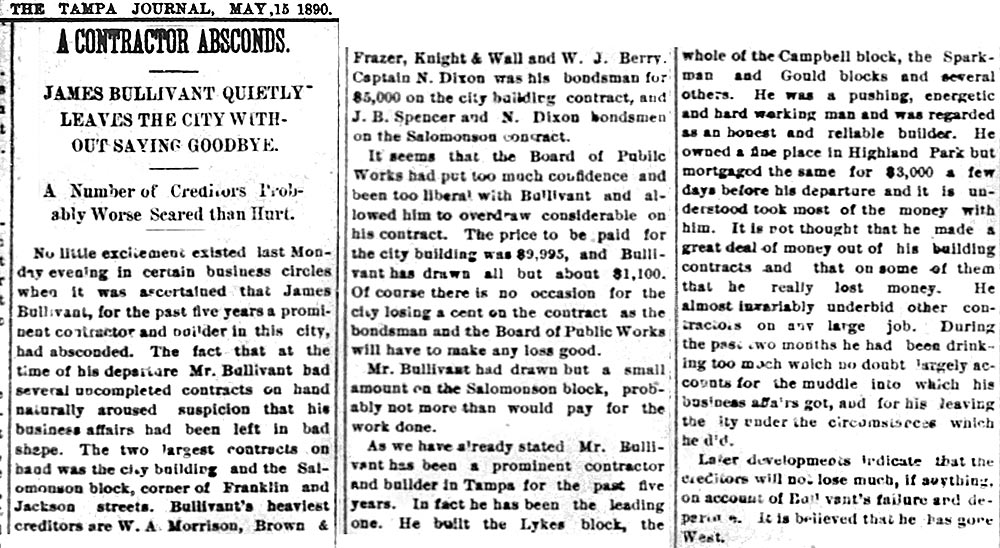
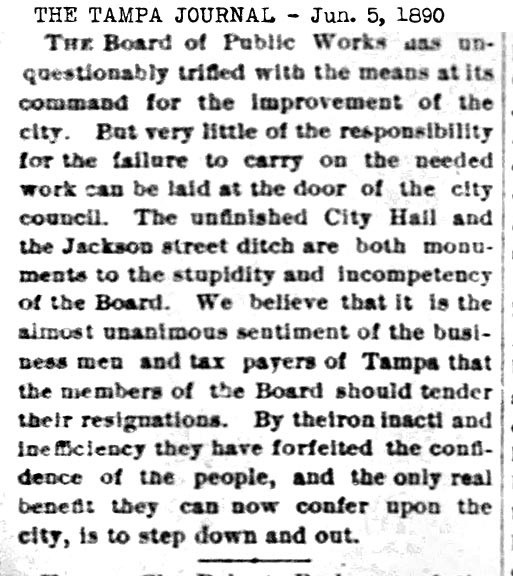
1890, June 5 - The owner and editor of
the Tampa Journal, H. J. Cooper, took the Bullivant disappearance as
an opportunity to criticize the Board of Public Works by stating the
"unfinished City Hall and the Jackson Street ditch are both
monuments to the stupidity and incompetency of the Board" and "We
believe that it is the unanimous sentiment of the business men and
tax payers of Tampa that the members of the Board should tender
their resignations."
PROGRESS ON THE 1890
CITY HALL
|
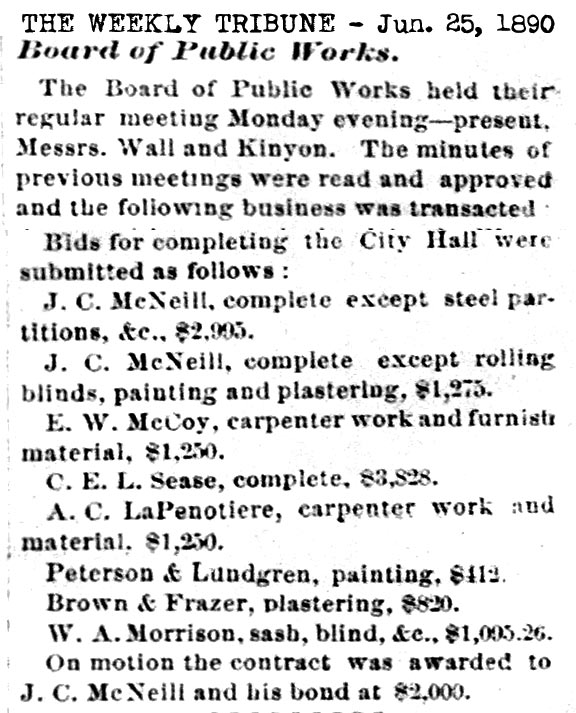 |
In late June of 1890, the city
contracted with J.C. McNeill to complete the construction of
city hall. It would appear that the structural part of
the project was complete, as McNeill was owner of "The Novelty
Wood Works" specializing in turned and scroll work, mantels,
doors and sashes. McNeill would likely have completed
the other tasks for which bids were submitted; steel
partitions, plastering, painting, doors, blinds, and sashes.
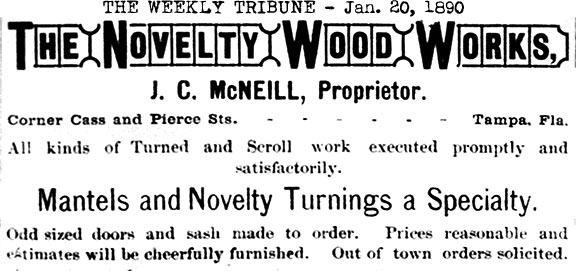 |
|
|
|
|

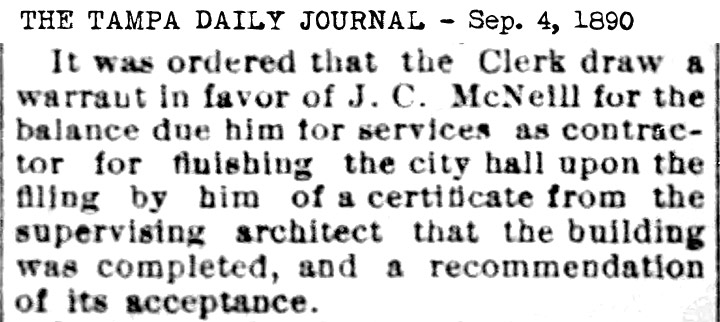 |
|
|
In those
days, the mayor served as judge in the municipal court.
Below
are the cases that came before Mayor Herman Glogowski in August of
1890.
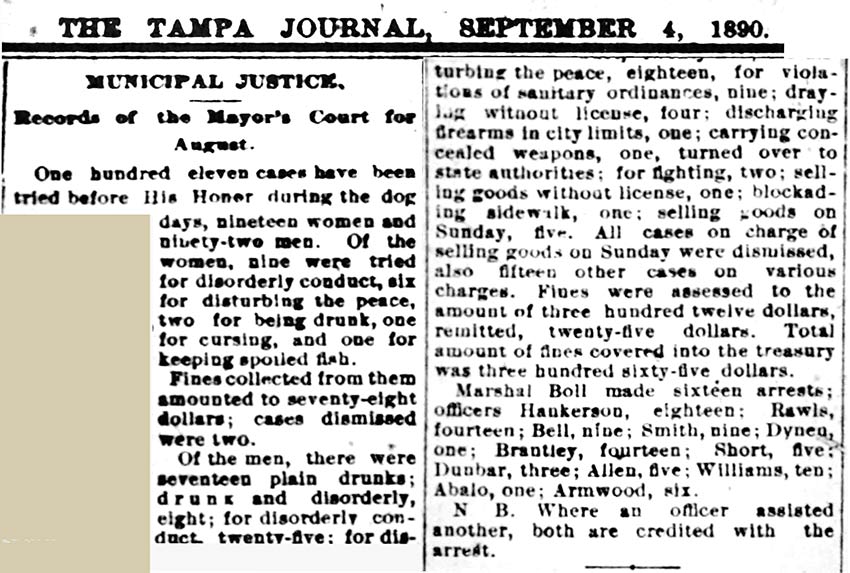
DESCRIPTION OF INTERIOR LAYOUT
The Sep. 4 article below was part of a
much longer story which began with the reporter's fictional version
of the city hall officials' wailing disappointment and lamenting
that the furnishings weren't as extravagant as they previously
described in an April 24 of the same style,
where he interviewed the City Clerk asking how the place was going
to be furnished (excerpts of which appear earlier in this
feature above.)
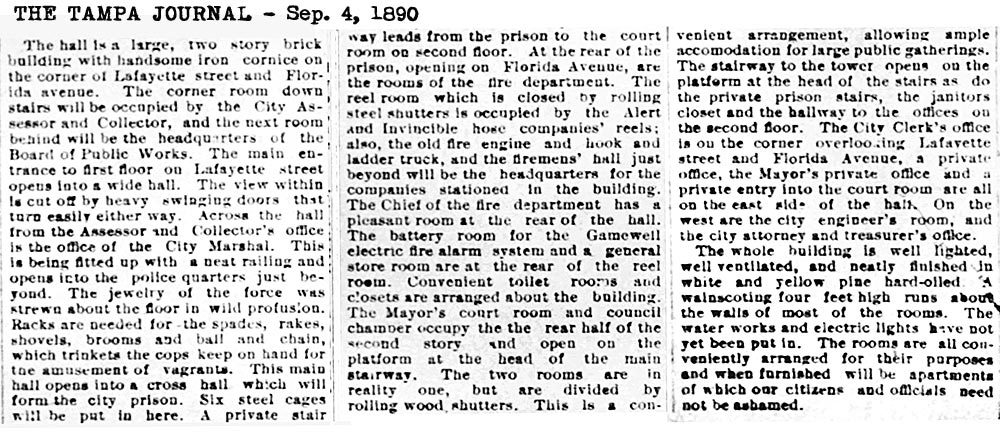
TAMPA'S PROSPECTS FOR THE FUTURE
LOOKS ROSY, NEW COURTHOUSE PLANNED
Synopsis of Sept. 11, 1890 article in the Tampa Journal, "The
Immediate Future"
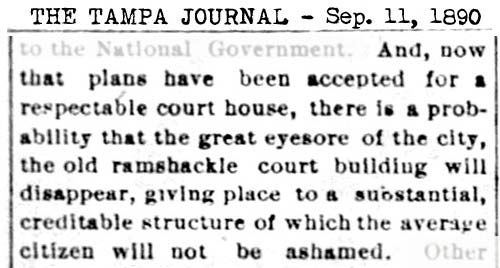 Tampa's
"dull season" has ended, business is picking up, and none have
failed. Retail and wholesale is up and on the increase. A number of
buildings are getting ready for occupation, and many more under way
or just starting. Residences of a "better class" and a number of
"tasteful cottages" were just completed or under way. The city
is spreading out in all directions, real estate values are up, and
the S. Fla. railroad is expanding facilities for freight and
passenger purposes. The deepening of the channel has increased
business at the port considerably and will bring in millions to
Tampa's wealth. The magnificent Tampa Bay Hotel is getting
ready for occupancy and will attract thousands of tourists from all
over the world, and be a "source of pride and profit to Tampa's
citizens." The crematory will promote cleanliness and health,
and the water works system, electric light facilities and fire alarm
all contribute to the general satisfaction. The deepening of
the channel, establishment of a weather bureau, and a bonded
warehouse for the U.S. Customs service will prove Tampa's importance
to the National Government. Plans for a new respectable
courthouse are under way, and the ramshackle eyesore will be done
away (the old "Breaker courthouse.") Other towns in the county
have kept up with the building, sowing, planting and trading on a
gradual increase, and "Tampa may well feel satisfactory with her
present prosperity."
See the
whole article here. Tampa's
"dull season" has ended, business is picking up, and none have
failed. Retail and wholesale is up and on the increase. A number of
buildings are getting ready for occupation, and many more under way
or just starting. Residences of a "better class" and a number of
"tasteful cottages" were just completed or under way. The city
is spreading out in all directions, real estate values are up, and
the S. Fla. railroad is expanding facilities for freight and
passenger purposes. The deepening of the channel has increased
business at the port considerably and will bring in millions to
Tampa's wealth. The magnificent Tampa Bay Hotel is getting
ready for occupancy and will attract thousands of tourists from all
over the world, and be a "source of pride and profit to Tampa's
citizens." The crematory will promote cleanliness and health,
and the water works system, electric light facilities and fire alarm
all contribute to the general satisfaction. The deepening of
the channel, establishment of a weather bureau, and a bonded
warehouse for the U.S. Customs service will prove Tampa's importance
to the National Government. Plans for a new respectable
courthouse are under way, and the ramshackle eyesore will be done
away (the old "Breaker courthouse.") Other towns in the county
have kept up with the building, sowing, planting and trading on a
gradual increase, and "Tampa may well feel satisfactory with her
present prosperity."
See the
whole article here.
On Sept.17, 1890, another resolution
was passed to purchase furniture not to exceed $1,000. On Oct.
8, 1890, bids were advertised for the provision of jail cells for
the city hall.
|
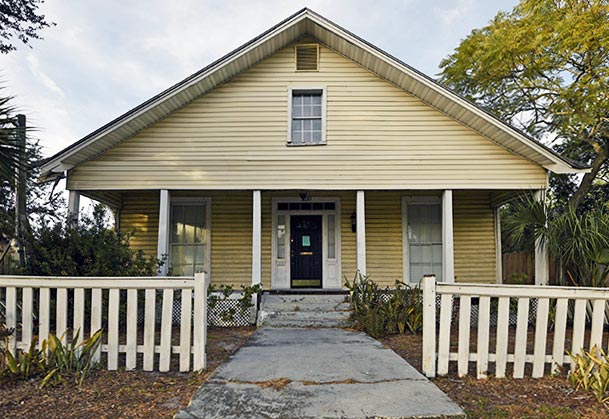
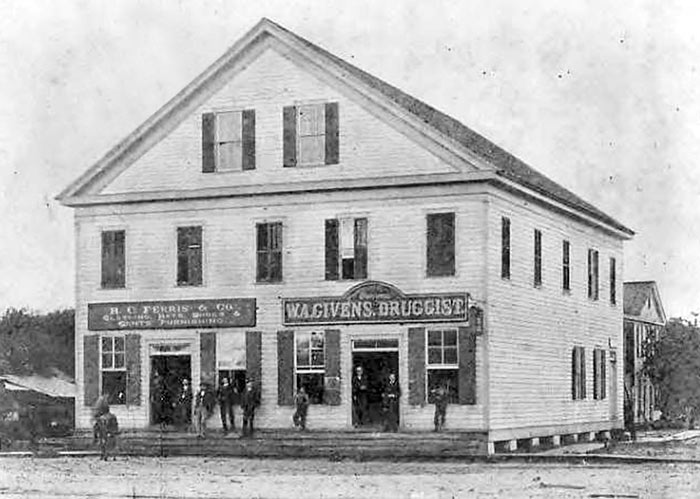
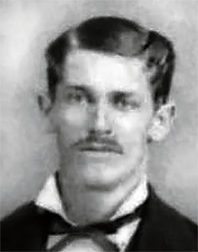
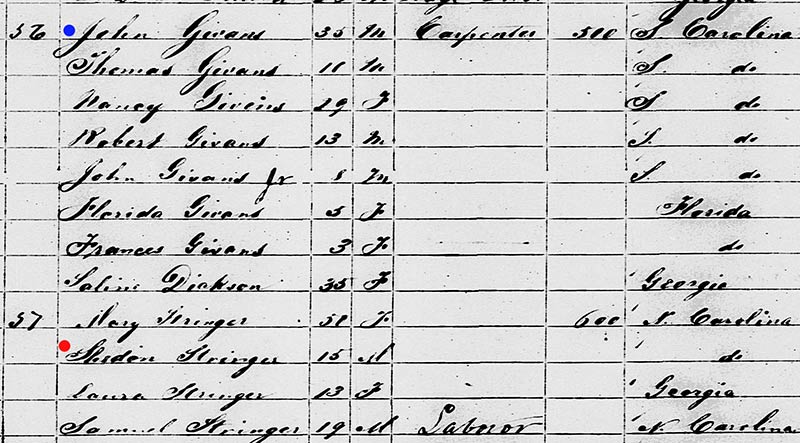
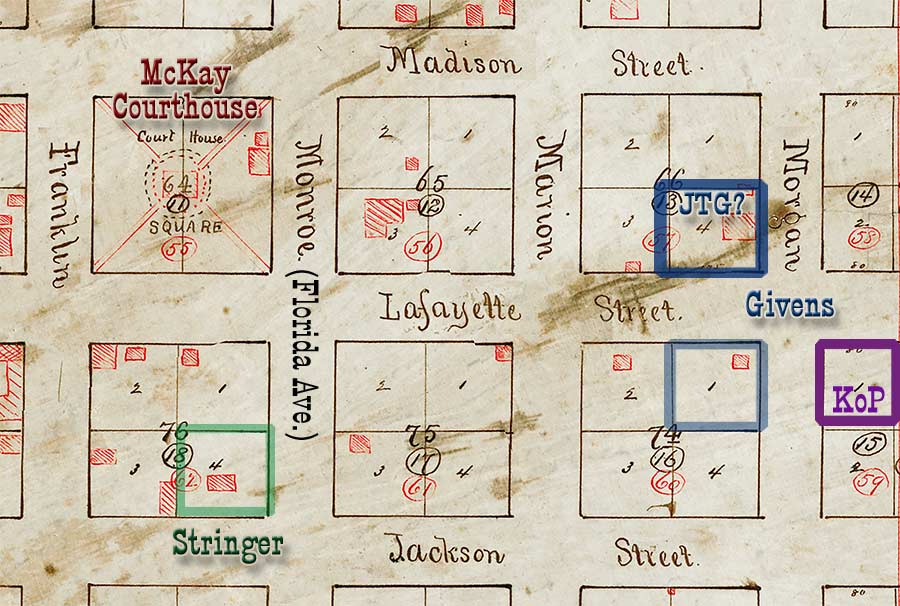

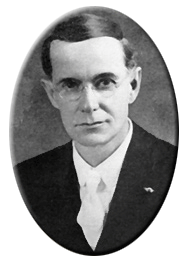
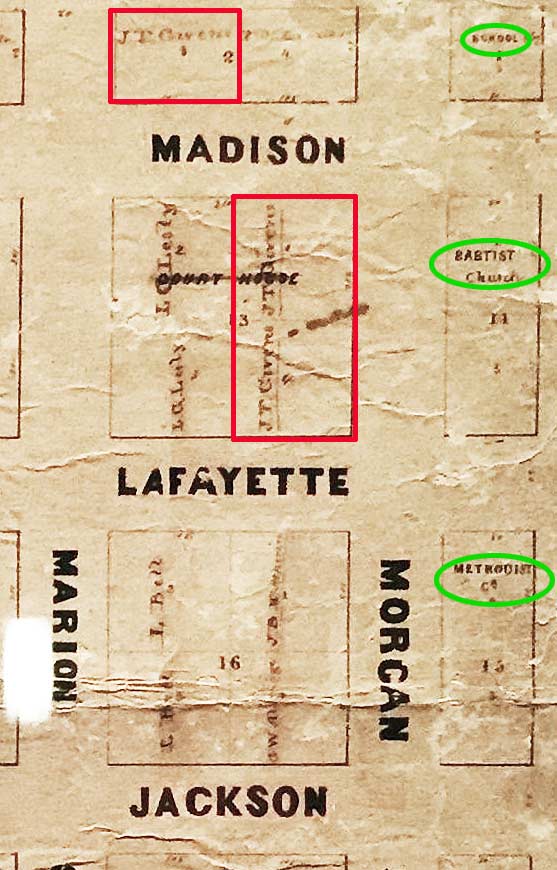



 On
the 2nd floor is the Court Room, 42 by 45 ft., and two spacious Jury
rooms, with a passage extending from the south entrance, between the
jury rooms to the Court-room. A projecting Portico, an each end, the
whole width of the building supported by heavy Grecian Columns. A
double flight of stairs ascends from each end of the building,
landing - on the 2nd floor of the porticos. The roof is mounted with
a dome and tower, 18 ft in diameter, and 24 ft high, covered with
tin, or zinc.
On
the 2nd floor is the Court Room, 42 by 45 ft., and two spacious Jury
rooms, with a passage extending from the south entrance, between the
jury rooms to the Court-room. A projecting Portico, an each end, the
whole width of the building supported by heavy Grecian Columns. A
double flight of stairs ascends from each end of the building,
landing - on the 2nd floor of the porticos. The roof is mounted with
a dome and tower, 18 ft in diameter, and 24 ft high, covered with
tin, or zinc.









 STRINGER PROPERTY SELECTED TO BUILD
NEW CITY HALL
STRINGER PROPERTY SELECTED TO BUILD
NEW CITY HALL
















 Tampa's
"dull season" has ended, business is picking up, and none have
failed. Retail and wholesale is up and on the increase. A number of
buildings are getting ready for occupation, and many more under way
or just starting. Residences of a "better class" and a number of
"tasteful cottages" were just completed or under way. The city
is spreading out in all directions, real estate values are up, and
the S. Fla. railroad is expanding facilities for freight and
passenger purposes. The deepening of the channel has increased
business at the port considerably and will bring in millions to
Tampa's wealth. The magnificent Tampa Bay Hotel is getting
ready for occupancy and will attract thousands of tourists from all
over the world, and be a "source of pride and profit to Tampa's
citizens." The crematory will promote cleanliness and health,
and the water works system, electric light facilities and fire alarm
all contribute to the general satisfaction. The deepening of
the channel, establishment of a weather bureau, and a bonded
warehouse for the U.S. Customs service will prove Tampa's importance
to the National Government. Plans for a new respectable
courthouse are under way, and the ramshackle eyesore will be done
away (the old "Breaker courthouse.") Other towns in the county
have kept up with the building, sowing, planting and trading on a
gradual increase, and "Tampa may well feel satisfactory with her
present prosperity."
Tampa's
"dull season" has ended, business is picking up, and none have
failed. Retail and wholesale is up and on the increase. A number of
buildings are getting ready for occupation, and many more under way
or just starting. Residences of a "better class" and a number of
"tasteful cottages" were just completed or under way. The city
is spreading out in all directions, real estate values are up, and
the S. Fla. railroad is expanding facilities for freight and
passenger purposes. The deepening of the channel has increased
business at the port considerably and will bring in millions to
Tampa's wealth. The magnificent Tampa Bay Hotel is getting
ready for occupancy and will attract thousands of tourists from all
over the world, and be a "source of pride and profit to Tampa's
citizens." The crematory will promote cleanliness and health,
and the water works system, electric light facilities and fire alarm
all contribute to the general satisfaction. The deepening of
the channel, establishment of a weather bureau, and a bonded
warehouse for the U.S. Customs service will prove Tampa's importance
to the National Government. Plans for a new respectable
courthouse are under way, and the ramshackle eyesore will be done
away (the old "Breaker courthouse.") Other towns in the county
have kept up with the building, sowing, planting and trading on a
gradual increase, and "Tampa may well feel satisfactory with her
present prosperity."
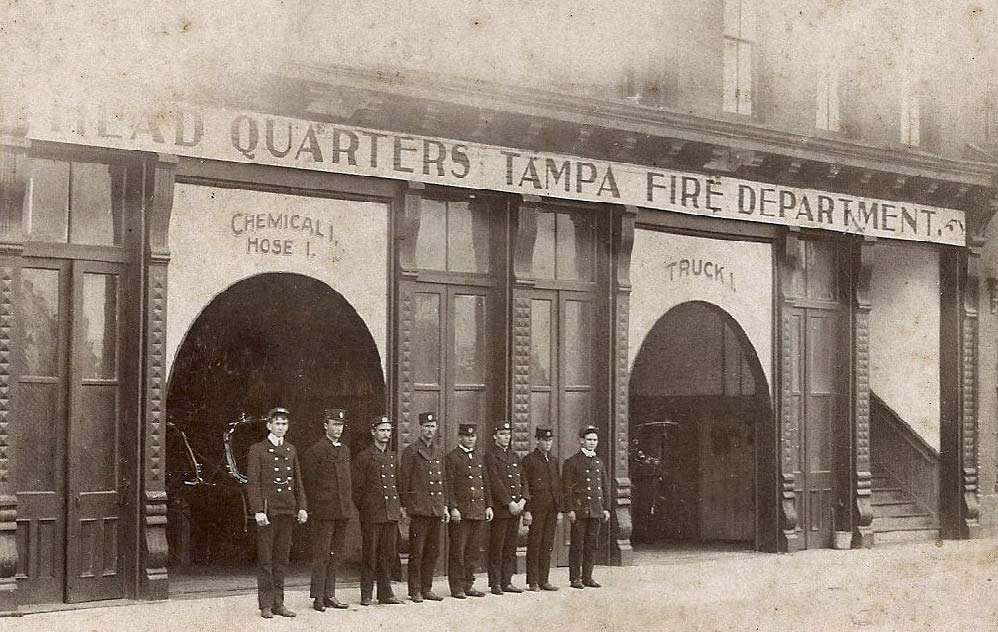
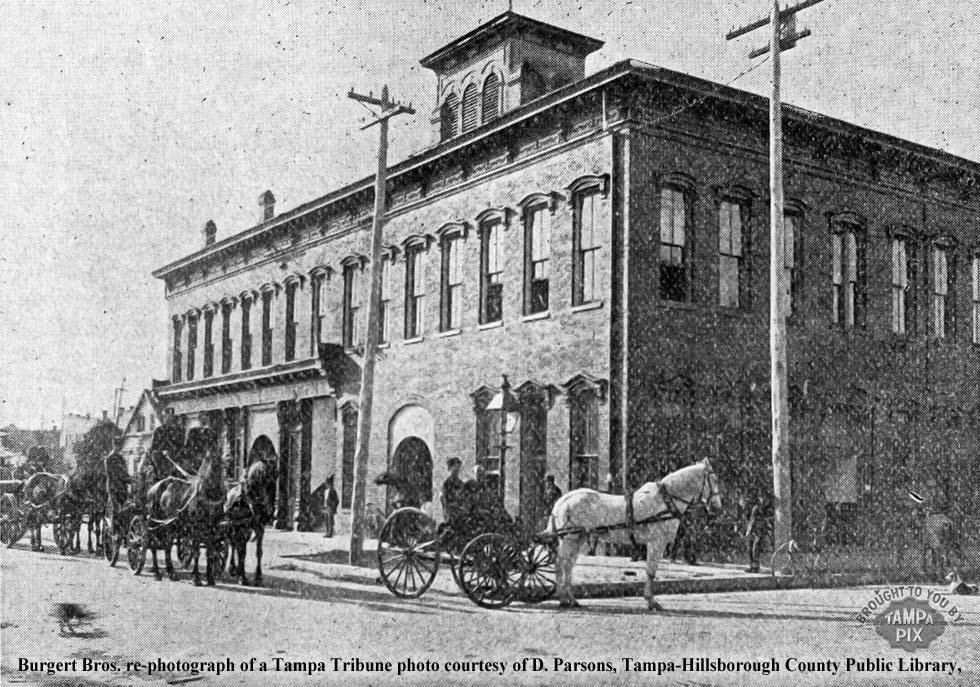
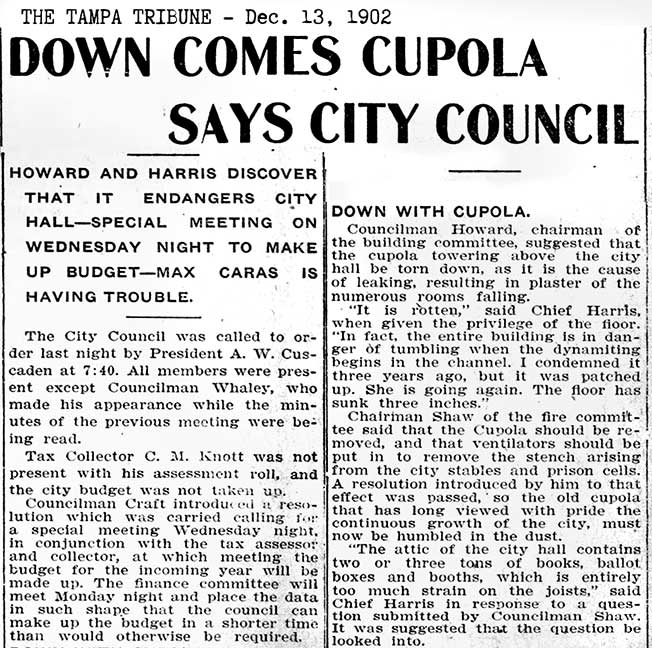
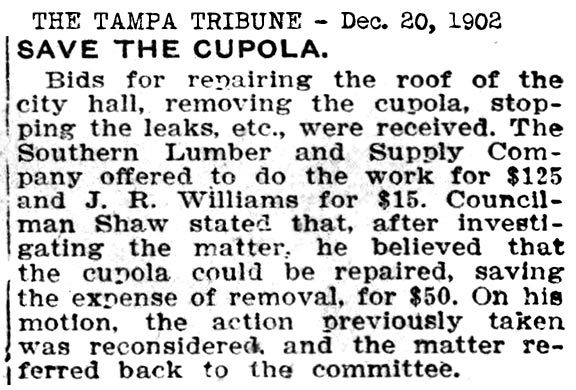
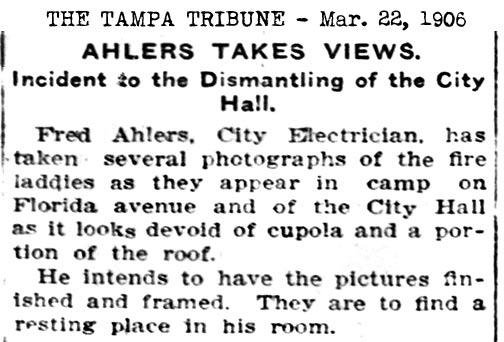
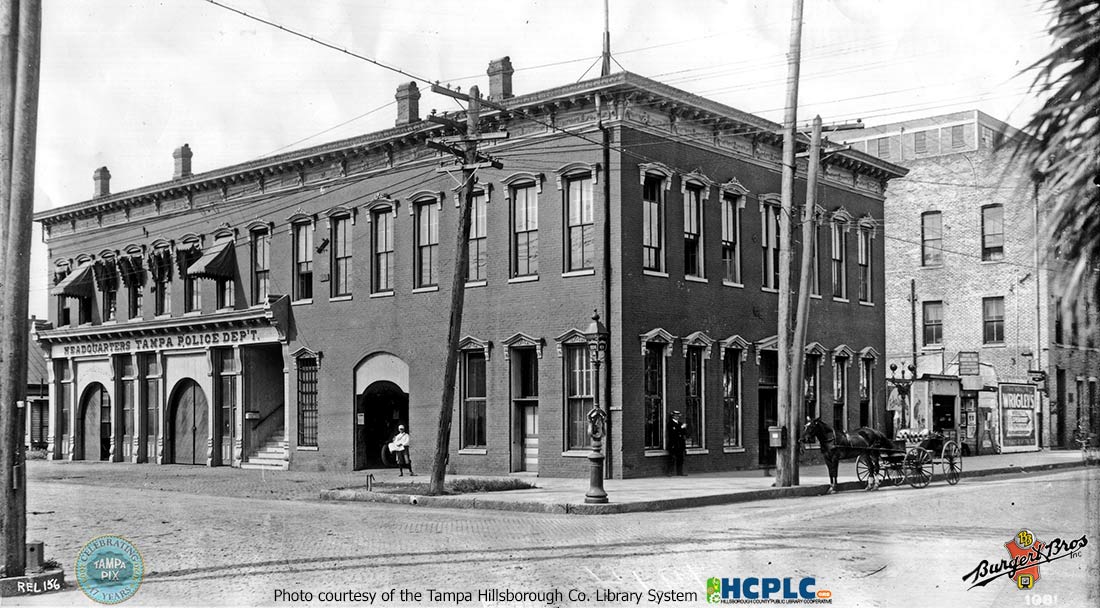
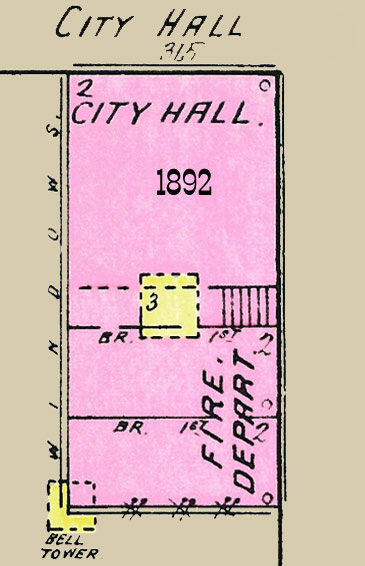
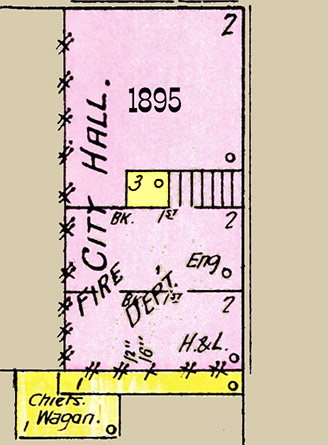
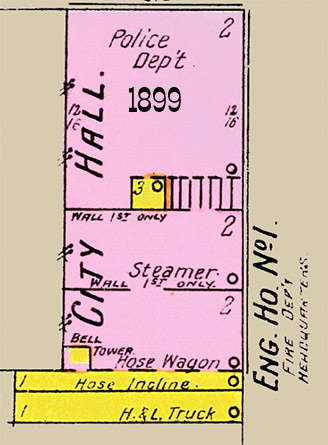
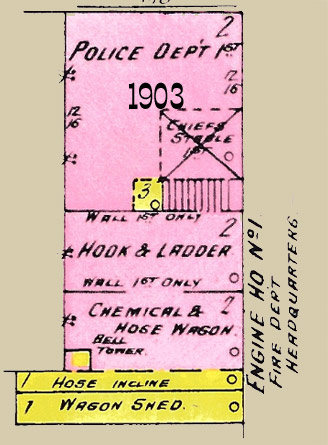
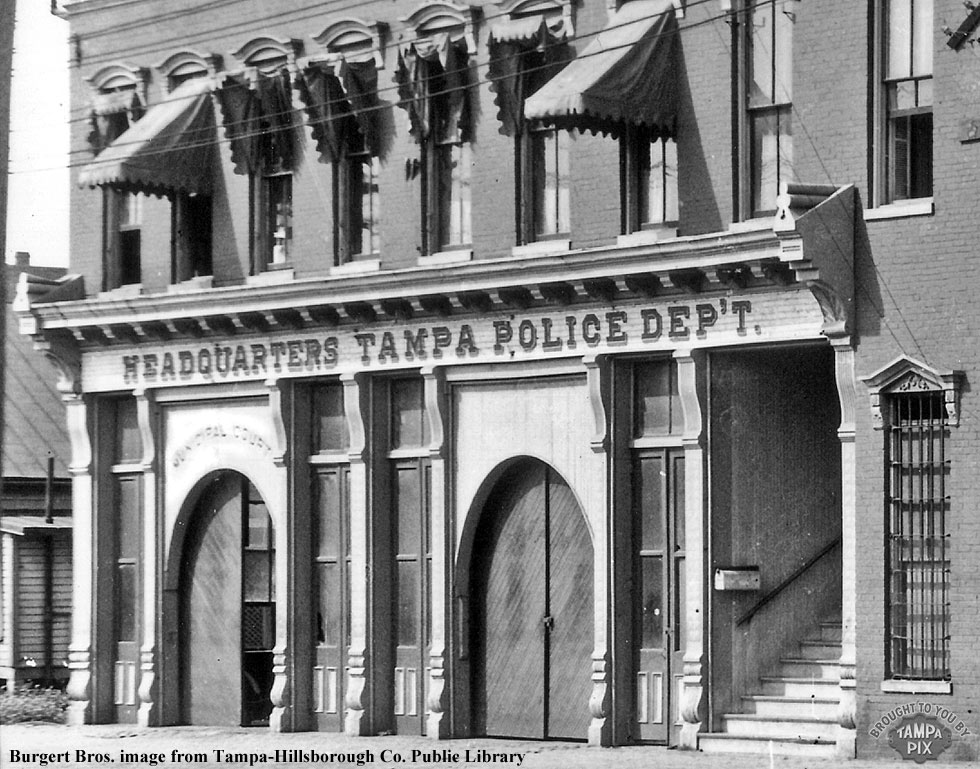


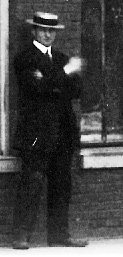
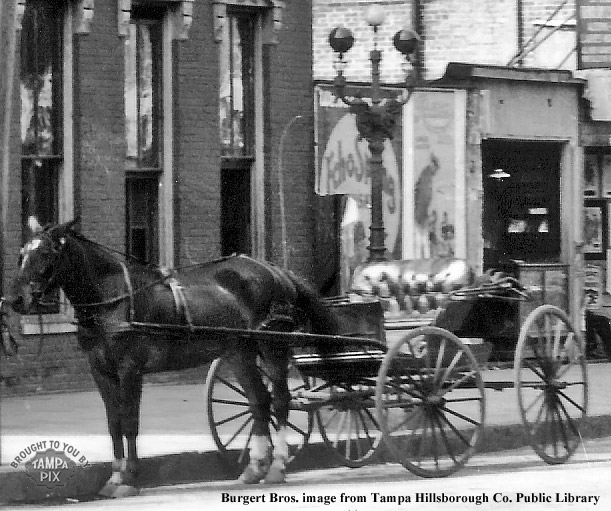


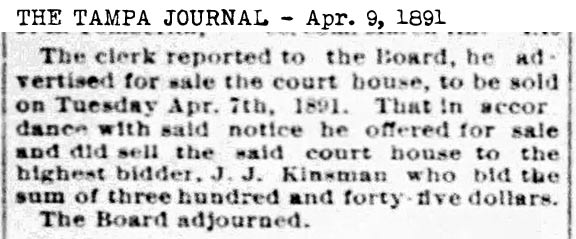
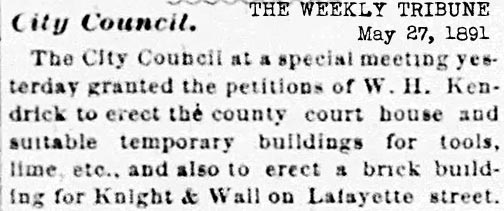
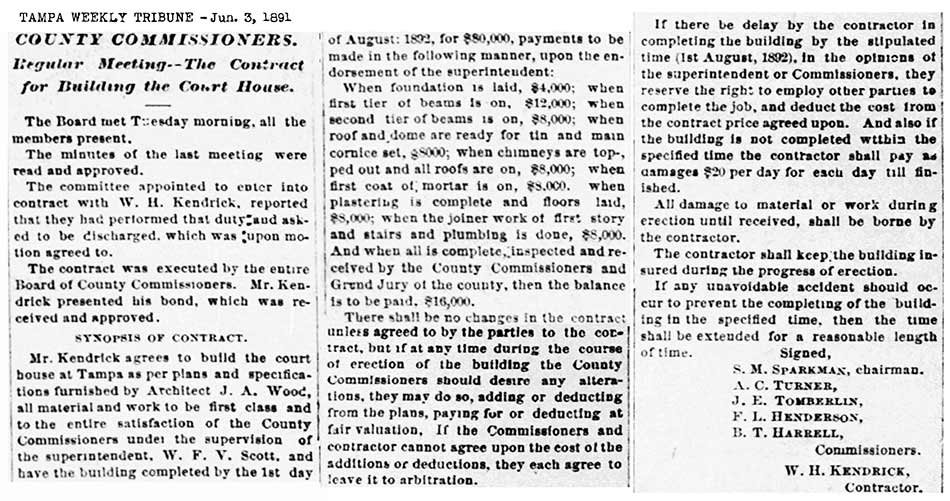
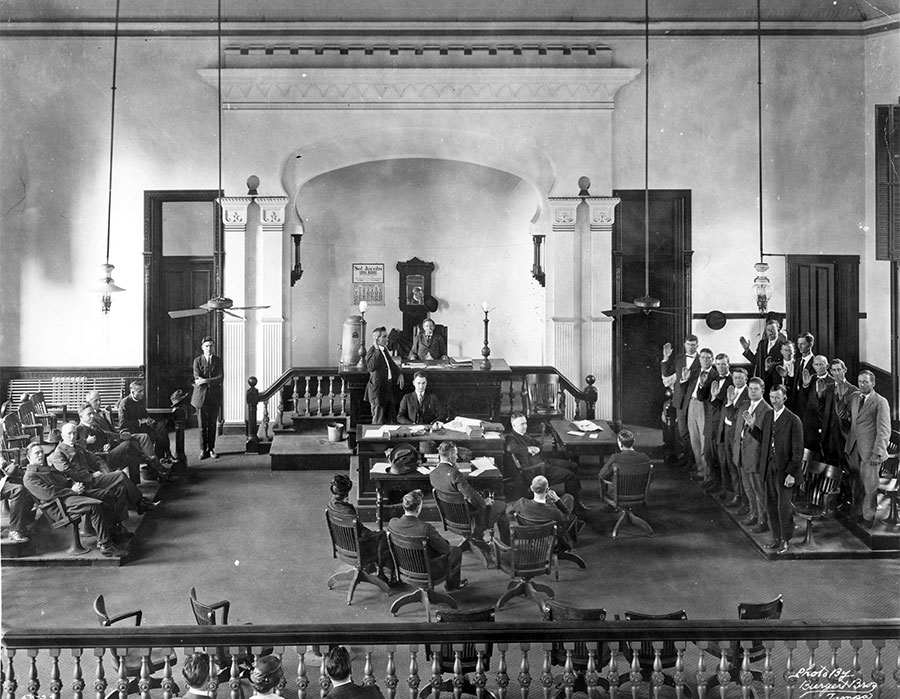
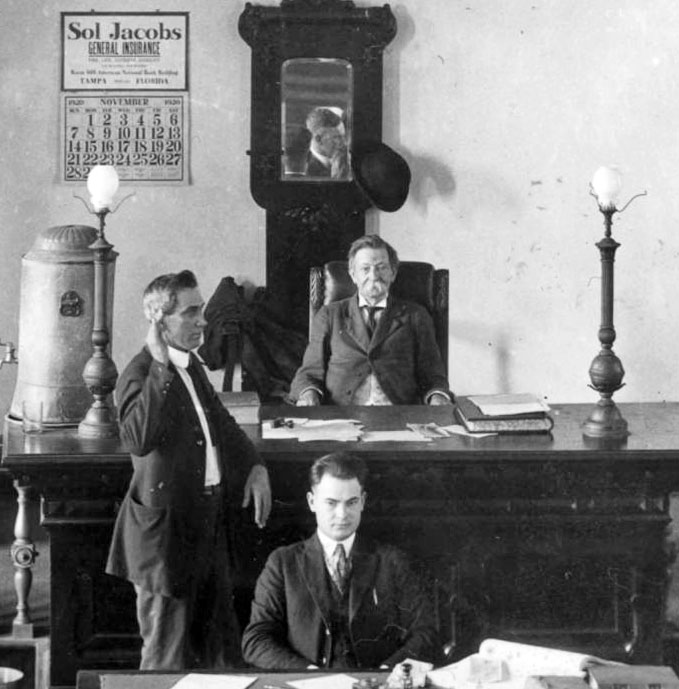 |
|